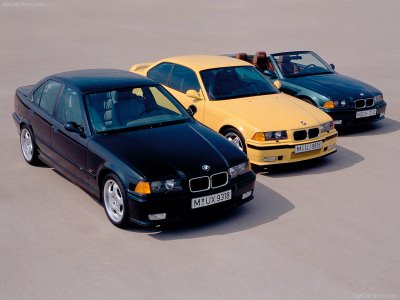1990-2000 BMW 3 Series (E36): Setting the Bar

BMW 325i, M3 and Convertible
Few cars have received so much acclaim from the motoring press and public alike as the 3 Series from BMW. The 3 Series established it’s dominance in the pecking order of compact entry level luxury cars atleast two generations before the E36 platform was introduced in Europe in 1990. It could be said that every sporty car wants to be a BMW. you’d think that was true with all the cars that compare themselves to the 3 Series, and for good reason. The 3 Series has been called the best handling car in the world at any price range. Quite a lofty statement, considering that the car was available as a coupe, sedan, hatchback, convertible, estate (wagon) and later it’s platform spawned a roadster and small SUV. It offered something for everyone from snobs to gearheads. In fact, so vast was it’s popularity that it was built in Germany, South Africa and South Carolina.
It’s easy to get confused with all the variations. In North America, the choices were simpler and were offered with two or three engine sizes, usually denoted by number designations: 318, 323, 325, 328, and M. 318’s were only offered with 1.8 L 4 cylinder engines while all other variations had inline sixes. The most celebrated of the 3 Series cars were the M versions. Introduced in 1993 as 94 models in the US, the M coupe and later sedan was initially available with a 2.9 L inline 6. European version had a larger more powerful 3.2 L good for 317 hp vs. the U.S. 291. Non M cars had tuning packages that gave them M like visual attributes, usually special bumpers, wheels or seats.
regardless of what version you drove, all cars had a 50/50 weight balance (or close) and featured an advanced Z-axle multi-link suspension setup. The advancements continues inside with an integrated computer system that checked engine functions and suggested maintainance schedules based on how the car was driven, as opposed to a set timetable. At one point early in the evolution of the car, GM transmissions were used for many of the automatics. Five speed manuals and automatics were eventually offered, with the M3 using a 6 speed manual in it’s final years in E36 form. The inline sixes were considered some of the most advanced in the world and offered efficiency and realitivelly broad power band, especially in versions with the VANOS variable valve technology. Horsepower figures ranges from 170 in the 323i to 190 in the 328i.
Not everything BMW did was golden. In its attempt to capture more market share by introducing an entry level car to the American market, called the Compact was a sales disappointment. Similar in appearance from most angles to the other cars in the line, it used the previous generation’s suspension and the interior was noticeably spartan compared to the typical 325. The experiment failed in America, for a couple of reasons. Americans were not sold on the ideal of a BMW hatchback, as the concept said cheap to most Yanks. VW’s Golf, it’s nearest competitor, cost less and offered more standard features. The 318ti retains a devoted cult following, especially the M Technic version with it’s M3 bumpers and rims.
During the time of the E36, BMW was solidly ahead of it’s emerging Japanese entry luxury competition. By the end of it’s life cycle, the competition had caught up in many respects, but were still unable to match the magical combination of ride quality, road holding and comfort that was the hallmark of every BMW, regardless of how much power it had. Some believe that the E36 was the last of the 3 Series that truly gave the driver the feel of a true driver’s car. The E36 gave way to the larger and more refined E46 in 2000 as BMW gradually replaced the as sedan, coupe and finally convertible.

1995 BMW 318ti
